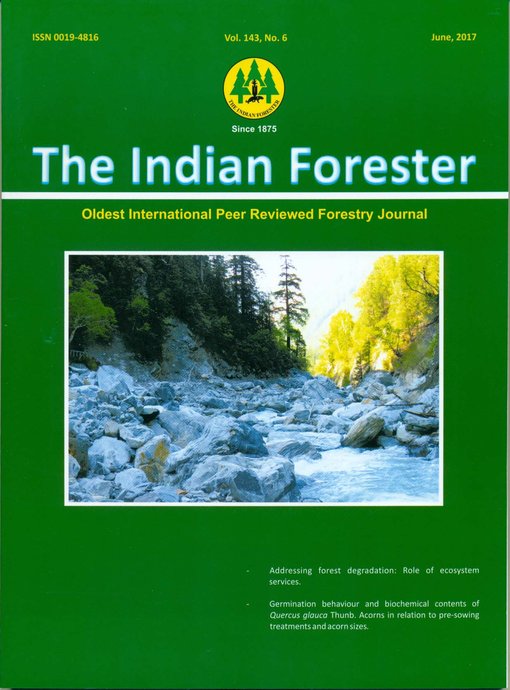Morphological Studies in Acer Species (Sapindaceae)
DOI:
https://doi.org/10.36808/if/2017/v143i6/115835Keywords:
Acer, Cluster Analysis, Morphology.Abstract
Acer (Sapindaceae) is a genus with 10 species in Iran. These plants are of economic, ornamental and medicinal importance. Totally 37 populations of seven Acer species as Acer velutinum, A. monspessullanum, A. platanoides, A. campestre, A. cappadocicum, A. negundo and A. palmatum distributed in different parts of Iran were studied in this project. In order to study the morphological variation 13 quantitative and 25 qualitative features were used. Multivariate statistical analysis was done by use of SPSS Statistical software. Factor analysis revealed that more than 44% of total observed variation is dealt with width of fruit wing, leaf width, length of fruit wing, petiole length, length of fruit wing and leaf length. In second factor peduncle and samara length are of diagnostic importance in studied species. Species relationships were evaluated by use of cluster analysis and ordination based on principal component analysis. Morphological features showed species separation and the close relationship between A. platanoides and A. cappadocicum.References
Davis J.C. (1965). Flora of Turkey (Aceraceae), Edinburgh at the University, 2: 655p.
Fang W.P. (1939). A monograph of Chinese Aceraceae, Contributions from the Biological Laboratory of the Science Society of China, Botany, Section. II: 1-346.
Fang W.P. (1966). Reyisio Taxorum Aceracearum Sinicarum, Acta Phytotaxonomica Sinica, 11(2): 139-189 (in Chinese).
Grimm G.W., Denk T. and Hemleben V. (2007). Evolutionary history and systematics of Acer section Acer – a case study of low-level phylogenetics, Plant Systematics and Evolution, 267: 215–253.
Grimm W.G., Renner S., Stamatakis S.A. and Hemleben V. (2006). A nuclear ribosomal DNA phylogeny of Acer inferred with maximum likelihood, Splits graphs and Motif analysis of 606 sequences. Evolutionary Bio Informatics Online, 2: 279-294.
Ingrouille M.J. (1986). The construction of cluster webs in numerical taxonomic investigation. Taxon, 35:541-545.
Karimi Z. (2009). Morphological Cluster analysis of some Acer species in Iran. J. Agriculture and Natural resources, 16(1):166-177 [in Persian with English Abstract].
Li J., Jipei Y. and Suzanne S. (2006). Phylogenetics of Acer (Aceroideae, Sapindaceae) based on nucleotide sequences of two chloroplast noncoding regions, Harvard Papers in Botany, 11(1): 101-115.
Momotani Y., (1962a). Taxonomic study of the genus Acer, with special reference to the seed proteins II analysis of protein, , Kyoto Imperial University. Memoirs of the College of Science, Series B., 29:81-102.
Momotani Y., (1962b). Taxonomic study of the genus Acer, with special reference to the seed proteins. III. System of Aceraceae, Kyoto Imperial University. Memoirs of the College of Science, Series B., 29:177-189.
Mozaffarian V. (2004). Trees and shrubs of Iran. Farhange Moaser Publication, Iran [in Persian].
Ogata K. (1967). A systematic study of the genus Acer, Bulletin of Tokyo university forest, 63:89-206.
Pax F. (18850. Monographie der Gattung Acer, Botanisches Jahrbücher für Systematik, P?anzengeschichte und P?anzeneographyraphie, Leipzig, 6: 287–374.
Pax F. (1886). Monographie der Gattung Acer, Botanisches Jahrbücher für Systematik, P?anzengeschichte und P?anzeneographyraphie, Leipzig, 7: 177–263.
Pax F. (1902). Aceraceae, Engler's Pflanzenreich, IV-163(8): 1-89.
Pojarkova A.I. (1933). Botanico-geographical survey of the Maples of the USSR. In connection with the history of the whole genus Acer L., ACTA Institute of Botanical Academy of Science. USSR, Series. 1, 1: 225–374.
Rechinger K. (1969). Flora Iranica, N.L. Druck-u, 61:55
Rehder A. (1949). Bibliography of cultivated trees and shrubs, Arnold Arboretum of Harvard University, 412-429.
Sabeti H. (1994). Jungles, trees and shrubs of Iran. Yazd University publication, Yazd [in Persian].
Skepner A. and Krane D. (1997). CpDNA of Acer saccharum and Acer nigrum are very similar, Ochilo Journal of Science, 97(4): 90-93.
Skepner A. and Krane D. (1998). RAPD reveals genetic similarity of Acer saccharum and Acer nigrum, Heredity, 80: 422-428.
Warsow G. (1903). Systematisch-anatomische Untersuchungen des Blattes bei der Gattung Acer mi"t besondererer Berucksichtingung der Milchsaftelement, Beihefte zum Botanischen Centralblatt, 15:493-601.
Watari S. (1936). Anatomical studies on the vascular system in the petioles of some species of Acer, with notes of the external morphological features, Journal of the Faculty of Science, Section, 3(5): 1-73.
Downloads
Downloads
Published
How to Cite
Issue
Section
License
Unless otherwise stated, copyright or similar rights in all materials presented on the site, including graphical images, are owned by Indian Forester.





